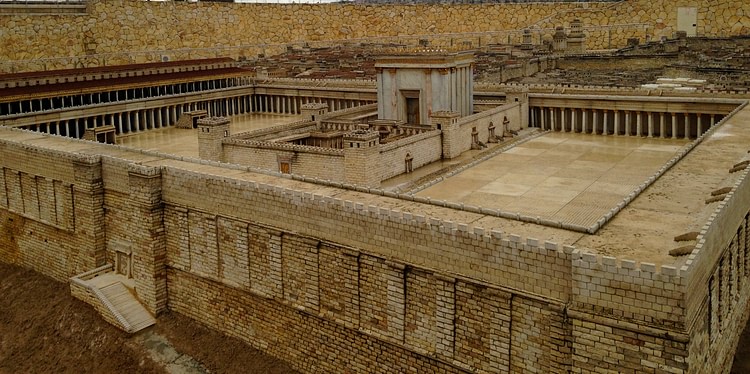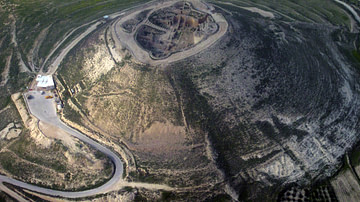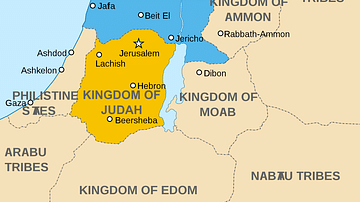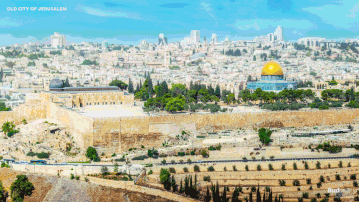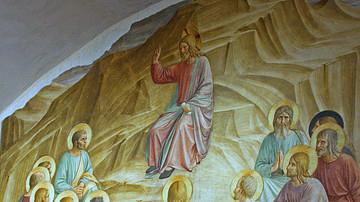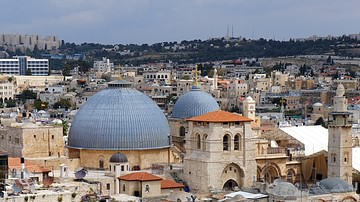According to Jewish tradition, the original Jerusalem Temple was ordained by Yahweh/God, as described in 2 Samuel 7:12 where Yahweh commands Nathan to tell David:
When your days are fulfilled and you lie down with your ancestors, I will raise up your offspring after you, who shall come forth from your body, and I will establish his kingdom. He shall build a house for my name, and I will establish the throne of his kingdom forever.
As well as the postexilic text, 1 Chronicles 28:2-7, where David declares:
I had planned to build a house of rest for the ark of the covenant of the Lord, for the footstool of our God; and I made preparations for building. But God said to me, 'You shall not build a house for my name, for you are a warrior and have shed blood'…He said to me, 'It is your son Solomon who shall build my house and my courts, for I have chosen him to be a son to me, and I will be a father to him. I will establish his kingdom forever if he continues resolute in keeping my commandments and my ordinances, as he is today.'
Socio-economic background
The construction of the First Temple period marked a transition from nomadic or migrant to a settled and established lifestyle. The Israelite, or Judean, community was no longer mobile, and therefore, the portability of the Tabernacle was no longer a priority. Not only was the community no longer mobile but a monarchy was also established, representing a significant transition in the political and socio-economic way of life. Interestingly enough, within close proximity to the Temple a palace was established, architecturally symbolizing to the Israelites that Yahweh was working through the king. In a sense, the Temple became the king's 'private chapel', presenting the Temple as an elitist form of worship, a concept that was strengthened by the power of the developing priestly class.
Location
The location of the Temple was not selected by chance but was rather erected on a site of great significance within the biblical tradition: Mount Moriah. It was upon Mount Moriah that Abraham was commanded to bring his son, Isaac, as a sacrifice to his God. His devotion ensured, God saved Isaac and created his covenant with Abraham (Gen. 22). In a rather poetic manner, the establishment of the Temple on this location appears to make complete sense. First and Second Temple Judaism was a religion of sacrifice, and it was in the Temple that such practices were enacted. The fact that the Temple was established on the same location that the Judeans believed Abraham nearly sacrificed his own son was surely no coincidence, and indeed this was precisely the message that the Judeans sought to create. Instead, the building was likely established before Gen. 22 was recorded, making the text an attempt to legitimize the location, and therefore, the establishment of the Temple. All in all, the building and the text are to be understood as representing two parts of a complicated system of sanctification and legitimization by the community in order to rationalize the transition from a migratory and mobile form of worship to one of alleged permanence.
Terminology
Although the Temple is referred to as a single institution here, it is important to note that the Jerusalem Temple was rebuilt at least three times in antiquity. The first was erected under Solomon, as is described in great detail within 1 Kings 5-6, approximately during the 10th century BCE. The second was built by returning exiles in approximately 515 BCE, while the third, and most elaborate, was developed under Herod in approximately 19-9 BCE, although it remained under renovations until its destruction in 70 CE. Generally, the Temple established by the returning exiles and Herod's Temple are conflated in scholarship and referred to as simply, the 'Second Temple', or the 'Second Temple period'. Although the physical characteristics described will refer to Second Temple evidence, the term 'Temple' here will represent all three as it is the general establishment of the institution that is of interest rather than the architectural differences between all three.
Worship & sacrifice
As the Temple became the center of worship with sacrifice playing an important, even crucial, role within ancient Judaism, laws and obligations were established in order to accommodate sacrificial requirements imposed on the Judean community, both within ancient Palestine and in the Diaspora. Both the book of Exodus and Deuteronomy attest to three mandatory pilgrimages: Pesach, Shavuot, and Sukkot.
Three times a year all your males shall appear before the Lord your God at the place that he will choose: at the festival of unleavened bread, at the festival of weeks, and at the festival of booths. They shall not appear before the Lord empty-handed; all shall give as they are able, according to the blessing of the Lord your God that he has given you (Deut. 16:16-17).
Three times in the year you shall hold a festival for me… No one shall appear before me empty-handed…Three times in the year all your males shall appear before the Lord God (Exodus 23:14-17).
These passages suggest that not only were acts of pilgrimage required but so were tithes and sacrificial offerings as is demonstrated in Deuteronomy 16:6.
[B]ringing there your burnt offerings and your sacrifices, your tithes and your donations, your votive gifts, your freewill offerings, and the firstlings of your herds and flocks.
Such passages demonstrate the significant economic role the Temple played in the ancient world. With large influxes of pilgrims, institutions such as hostels, public mikva'ot, money changers, and so on, would have developed in Jerusalem in order to accommodate and meet the needs of the individuals travelling to maintain sacrificial requirements.
Architectural design
The sacrificial practices that occurred within the Temple were reflected in the architectural design, with the division of the Temple platform into two separate courts: the Outercourt (non-Judean and Judean granted access), and the Innercourt (only Judeans granted access). The Innercourt was then divided into three smaller courts including the Court of Priests, which consisted of the Temple and altar, as well as the Court of Israel, and the Court of Women. As a result, worship was sexually segregated and access to the Holy of Holies was permitted only to the High Priest. As the Innercourt was accessible only to the Judeans, the Temple was marked as a space for Israelites alone, thereby demarcating the boundary of the Judean ethnos (people).
The end of the Temple period
Although access to the ancient synagogue was not restricted to the Judeans alone, several of the Temple rituals were transferred to the synagogue following the destruction of the Temple in 70 CE. Rituals such as the blowing of the shofar and the waving of the lulav during Sukkot were practiced within the synagogue, preserving the Temple traditions as well as a ritualistic aspect of Temple Judaism. While sacrifice was only permitted in the Temples, generations following the destruction of the Temple sought compromises and adaptations in order to preserve their cultural and ritualistic heritage, and in many situations the synagogue provided a means of continuity.
